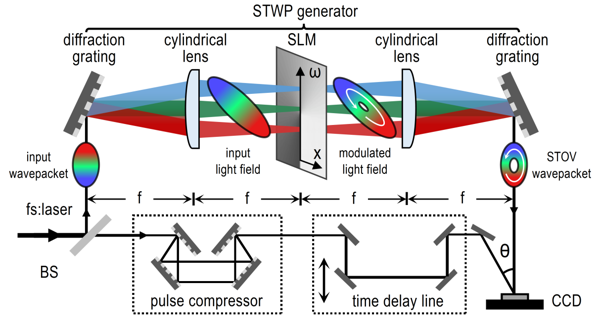Spatiotemporal (ST) wavepacket has been widely investigated since the invention of ultrafast laser. Conventional research on ST wavepackets focuses on studying spatiotemporal uncoupled wavepacket, meaning the space domain property and time domain property of the wavepacket are exploited separately.
In recent years, there are more and more research interests in studying spatiotemporal coupled (STc) wavepackets. Wavepacket with a specific ST field distribution can facilitate other physical process, making it a useful tool in many applications. For example, pulsefront-tilted ST wavepacket can achieve both phase matching and group velocity matching for a nonlinear crystal. When they are used to drive nonlinear process, the conversion efficiency can be significantly boosted. A spatially dispersed ST wavepacket can be "spatiotemporally" focused when it is focused by an objective lens and it can increase the axial resolution and the scanning speed of a multi-photon microscopy.
Besides being a powerful research tool, ST wavepacket itself is an interesting research topic due to its unique photonic property that is previously unavailable from ST uncoupled wavepackets. For example, spatiotemporal optical vortices (STOV) wavepackets can carry photons with transverse orbital angular momentum (OAM). A space-time light sheet can be engineered to become diffraction-free, achieve negative refraction, or propagate with a controllable group velocity. With all these interesting features, ST wavepackets have drawn more and more attention to the photonics research community.
Conventionally, ST wavepackets are generated by a Fourier-based wavepacket shaping technique. In such an approach, a phase and/or amplitude modulation is introduced by loading a spatial phase/amplitude mask on the spatial light modulator (SLM) within a standard zero-dispersion 4-f pulse shaper. The coordinates involved in this process are related by the Fourier transformation, making this approach less intuitive to use. Therefore, it is highly desirable if the phase/amplitude modulation can be directly "written" on the ST wavepackets through a straightforward spatial-to-ST mapping.
Recently, the Center for Complex Optical fields and Meta-Optical Structures (COSMOS) research group lead by Prof. Qiwen Zhan from University of Shanghai for Science and Technology develops a new wavepacket shaping technique that enables a direct sculpting of the optical field in space-time domain through a straightforward mapping relationship. The research results are now published in Photonics Research, Vol. 9, No. 11, 2021 (Qian Cao, Jian Chen, Keyin Lu, Chenhao Wan, Andy Chong, Qiwen Zhan. Sculpturing spatiotemporal wavepackets with chirped pulses[J]. Photonics Research, 2021, 9(11): 11002261).
The wavepacket shaping technique presented in this work achieves a direct imprint of ST modulation through taking advantage of the relationship between frequency and time of chirped pulses. We know the frequency components of a linearly chirped wavepacket are dispersed in time domain with a one-to-one mapping between its instantaneous frequency and time coordinate.
Thus, the wavepacket can be spatiotemporally sculpted by using the experimental setup shown in Fig. 1. The ST phase of the wavepacket can be precisely controlled by modulating the 2D phase mask of the SLM in this setup. The power of this mapping technique is demonstrated by realizing STOV polarity reversal, STOV collision, and STOV annihilation experiments. It is noteworthy that these STOV-related experiments are inaccessible by conventional Fourier-based wavepacket shaping techniques.
This very simple yet extremely flexible and powerful setup has enabled the creation and manipulation of complex ST wavepackets. More ST wavepacket related researches such as observing nonlinear collision of STOV wavepackets, STOV pump-probe experiment, and generating more complex STOV fields are yet to be investigated using this setup.
Furthermore, the approach described in this paper opens up tremendous new opportunities and can be converted to generate more complex ST optical fields by replacing the SLM device in this setup with other phase/amplitude masks. The scheme can be also adapted for generating ST fields at other spectral regimes as well as other fields that involve wave phenomena (such as electron beams, X-rays, and acoustic waves).
Another possible adaption of this method is to introduce the vectorial control over ST wavepackets by using proper photonic elements to engineer all four degrees of freedom for the input field and generate an arbitrary ST vectorial wavepacket. Such ST vectorial wavepacket can be of great interests for quantum optics, nanophotonics, and other light-and-matter interaction researches.

Figure. Schematic of spatiotemporal (ST) wavepacket generator and 3D wavepacket measurement system. An example for generating spatiotemporal optical vortice (STOV) is shown here. ST phase of the wavepacket is sculpted by the phase mask applied by spatial light modulator (SLM).


